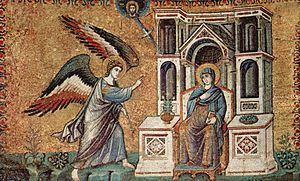Pietro Cavallini facts for kids
Pietro Cavallini was an Italian artist who lived a long time ago, from about 1259 to 1330. He was famous for his paintings and mosaics during the late Middle Ages.
About Pietro Cavallini
We don't know a lot about Pietro Cavallini's life, but we do know he was from Rome, Italy. He even signed his work pictor romanus, which means "Roman painter."
Some of his first important artworks were large paintings called frescoes in a church in Rome called the Basilica di San Paolo fuori le Mura. These frescoes showed stories from the New Testament and Old Testament, but sadly, they were destroyed in a fire in 1823.
Around 1293, Cavallini painted a famous fresco called The Last Judgment in the Church of Santa Cecilia in Trastevere in Rome. This painting is considered one of his best works. It showed a new artistic style called Roman naturalism.
What is Roman Naturalism?
Roman naturalism was a way of painting that made people and things look more real and lifelike. Artists tried to show depth and volume, making figures seem less flat and more like real people. This style was different from the older, flatter styles often seen in Byzantine art.
Cavallini's naturalistic style was very important. It influenced many artists in other Italian cities like Florence and Siena. For example, the famous Florentine artist Giotto was inspired by this style. Giotto's work in the Arena Chapel in Padua shows how he used this naturalism to create more individual and realistic figures, which became a key part of the Renaissance art that followed.
Cavallini also worked in Naples for King Charles II of Anjou starting in 1308. He created art for churches like San Domenico Maggiore and Santa Maria Donnaregina. He returned to Rome before 1325 and continued to create beautiful mosaics.
Pietro Cavallini's Artworks
Here are some of Pietro Cavallini's known works:
- Jael and Tisseran (date unknown), a painting using watercolour.
- Scenes from the life of Mary (around 1298), which are mosaics in the apse (the curved part) of the Basilica di Santa Maria in Trastevere in Rome. These six scenes were ordered by Bertoldo Stefaneschi and even include a donor portrait of him (a picture of the person who paid for the art). People admire these mosaics because they look very realistic and show early attempts at perspective (making things look far away or close up).
- Nativity of the Virgin (Mary's birth)
- Annunciation (when an angel told Mary she would have a baby)
- The Birth of Jesus
- Adoration of the Magi (the wise men visiting Jesus)
- Presentation in the Temple (Jesus being presented at the temple)
- Dormition (Mary's passing)
- The Last Judgment (1295–1298), a large fresco painting in Santa Cecilia in Trastevere in Rome.
Other artworks believed to be by Cavallini include the apse paintings at San Giorgio al Velabro in Rome and the apse mosaic of the San Crisogono church, which shows Mary with Sts. Sebastian and Chrysogonos. The illustrated Clement Bible is also thought to be by Cavallini or his workshop.
See also
 In Spanish: Pietro Cavallini para niños
In Spanish: Pietro Cavallini para niños


